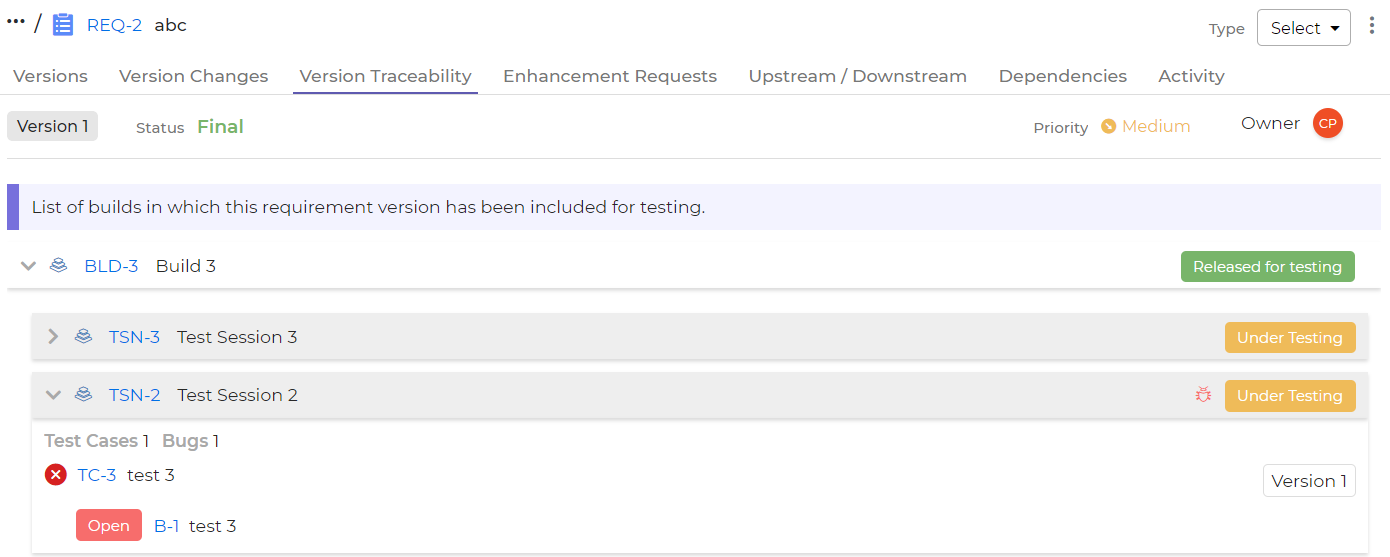Looking to capture and understand your client’s changing requirements? Want to ensure that the final product is bug- and defect-free? Or maybe, you want your QA process to be streamlined and effective. Perhaps, you’d like to ensure that no requirement is left out during the testing cycle. In each of these scenarios, tracking your project requirements can become challenging. This is why you need to leverage the power of a Requirements Traceability Matrix. This multi-functional document empowers you to test your requirement with all possible scenarios and use cases.
Moreover, you can map your requirements to every test case without errors and confusion. If you are in an industry or vertical that is heavily reliant on compliance, this document is a boon for you. Let’s understand what is Requirements Traceability Matrix in greater detail.
What is a Traceability Matrix (TM)?
A Traceability Matrix refers to a worksheet that co-relates two-baseline documents. These documents mandate a many-to-many relationship with the end-goal of understanding the completeness of the relationship. If you want to keep tabs on your requirements list and want to ensure that the project requirements are fulfilled on time, a Traceability Matrix can be a powerful tool.
So, What is Requirements Traceability Matrix (RTM)?
A Requirements Traceability Matrix–or RTM as it is commonly known– is a document that:
- Outlines different types of requirements based on the desired outcome, such as business requirements, user requirements, UI requirements, functional and non-functional requirements, technical requirements, and more
- Showcases the key relationship between artifacts (think: source code, tests, issues, etc.) and requirements
- Maps, tracks, and verifies whether all your requirements are connected to the relevant test scenarios and cases or not
- Checks the status (pass or fail) as well as the progress of the current project requirements
- Is used to prove whether the requirements have been accounted for in the testing phase or not
- Captures important details such as tests, requirements, test results, and issues
- Helps assess the impact of changing project requirements on workflows, test cases, software code, training materials, and so on
- Helps adhere to quality standards, stay competitive, and create safe products
Some of the key parameters that you must include within a Requirements Traceability Matrix include the following:
- Requirement ID
- Requirement type and a short description
- Test cases with the current status
The takeaway:A Requirements Traceability Matrix is a single document that is produced at the end of the software development cycle. Think of this document as an indicator to validate whether the requirements have been checked via test cases. In the end, no functionality or requirement proposed by the client should go unchecked during the software testing phase.
How to Create a Traceability Matrix?
The conventional method of creating a Requirements Traceability Matrix is with spreadsheets. You can also look at useful online video tutorials or take the help of readymade templates to do the same. Alternatively, you can use other specialized tools and software to make the process quicker.
No matter which tool you go for, you need to follow these steps to create a useful RTM:
Step 1: Start by defining your RTM goals and make sure to give comprehensive reasoning behind each RTM showcased.
Step 2: Collate the necessary requirement documentation (think: technical requirement document, functional requirement document, business requirement document, etc.).
Step 3: To make things easier, you can create a spreadsheet. Here, you can create relevant columns such as business requirements, test cases, bugs, results, etc. You should also record the requirement ID number for every requirement from your BRD.
Step 4: The next step is to record all corresponding functional requirements with your business requirement.
Step 5: Then, you should focus on connecting the test case IDs to the corresponding functional requirements.
Step 6: The final step entails updating your traceability matrix if (and when) a change occurs.
Pro tip: Invest in foolproof traceability software like Xebrio to seamlessly establish the right relationship between your requirements and artifacts. The whole process of documenting the requirements becomes simple, and you can easily build test cases from requirements, create test runs from test cases, and resolve issues from test runs. We have mentioned the steps to create the entire traceability matrix using Xebrio in the following sections.
1. Forward Traceability:
This matrix helps:
- Understand whether the project is progressing in the right direction or not
- Ensure that each requirement is applied to the product and is tested thoroughly
- Map requirements to test cases effectively
2. Backward/Reverse Traceability:
This matrix is useful for:
- Ensuring whether the current product is heading in the right direction
- Tracing forward (for instance, from requirement to source code to test cases) as well as tracing backward (for example, from requirement to business goals)
- Verifying the scope of the project to ensure no additions are being made ad-hoc
- Mapping test cases to requirements
3. Bi-Directional Traceability (Forward and Backward):
This traceability matrix helps:
- Ensure all requirements are covered by test cases
- Analyze the impact of a change in requirements due to a ‘defect’ in a work product (and vice versa)
Real-World Applications of Different Types of Requirements Traceability Matrix
1. Test Matrix
Useful for:
- Software testing
- Helps prove that tests have been conducted
- Documents test cases, test results, and test runs
- Makes use of requirements and issues within the matrix
2. Compliance Matrix
Useful for:
- Industries that deal with complicated compliance regulations
- Helps demonstrate compliance to auditors and takes the pressure off of audits
- Allows you to easily understand what you need to develop (as well as test)
- Enables you to document updates such as issue resolution, for instance, and document requirements changes in real-time
- Ensure that you keep track of your tests and test results with respect to the outlined requirements
3. Risk Matrix
Useful for:
- Managing risks and engaging in risk analysis
- Helps assess (whether you should eliminate, mitigate, or accept the risk)
- Helps manage risks before it becomes a big issue
- Demonstrates the severity of risks with a risk score and showcases the probability of the risk?
Top-5 Benefits of Requirements Traceability Matrix
Benefit #1: Helps users meet their business goals
How it can benefit users:
- Helps users to follow the life of a requirement
- Ensures that the requirements are able to fulfil their original business goals
- For instance, it can help users to understand if they were able to meet the required compliance requirements or not
Benefit #2: Allows users to drive the right kind of tests
How it can benefit users:
- Helps the quality assurance (QA) team to analyze what needs to be tested
- Improves test coverage by allowing users to map test cases to each requirement
- Helps demonstrate how the user’s requirements have been properly executed and prove compliance quicker
- Enables users to pass audits without chaos or fear
Benefit #3: Enables users to make informed decisions, particularly relating to requirements change
How it can benefit users:
- Helps users to drive informed decision-making throughout product development by allowing them to get visibility across development
- Helps analyze how a product design will be impacted by requirements as well as how a changing requirement affects product development
Benefit #4: Allows users to manage projects more easily and engage in effective versioning
How it can benefit users:
- Demonstrates the requirements coverage in the number of test cases
- Helps users to understand how their project is faring, manage the scope of the requirement, link requirements to tests, and gauge how realistically their team is able to meet the requirements
- Helps accelerate release cycles
- Helps understand the shift in requirements changes and how it impacts the overall project
Benefit #5: Empowers users to demonstrate key parameters and provide accurate documentation
How it can benefit users:
- Showcases important elements such as design status and execution status for a specific test case, wireframes, user stories, etc.
- Talks about whether a User Acceptance test should be done by the user
- Offers light on the current defects and helps users to prioritize them to prevent the backlog
- Showcases missing requirements and highlights document inconsistencies
How to create a Requirements Traceability Matrix with Xebrio
Xebrio’s traceability matrix eliminates the messiness of spreadsheets. To create the traceability matrix, follow the steps given below:

Step 1: To create a requirements traceability matrix using Xebrio, the first and most crucial step is to create a business requirements document early in the project lifecycle. Xebrio makes requirements traceability easy by allowing you to create a new requirement, add stakeholders, and finalize requirements.
Step 2: Collate the requirement documentation (think: technical requirement document, functional requirement document, business requirement document, etc.).
Step 3: Once you add your requirements, go to the test coverage tab, add the test cases, and finalize them. After you have added the test cases:
-
-
- Go to the test suite tab, create a new test suite, and add the finalized test cases.
-
- Create a new build.
-
- Add the test suites, and link the corresponding requirement to the build. Once everything is linked, you can release the build for testing.
-
Step 4: If any test cases fail or you raise bugs against those test cases, they will be visible in the linked requirements through the version traceability tab.
By establishing version traceability in Xebrio, you can increase transparency across your project, ultimately leading to project success.
Final Thoughts
A Requirements Traceability Matrix helps confirm 100% test coverage. This is why this powerful document must be made with mindfulness, attention to detail, and care. It enables you to spot missing requirements or document inconsistencies.
Moreover, you can also get insights into the current defects and the implementation status with a singular focus on organizational goals. If you want to empower your QA team with fewer revisits and less rework of test cases, create a robust Requirements Traceability Matrix document.






0 Comments